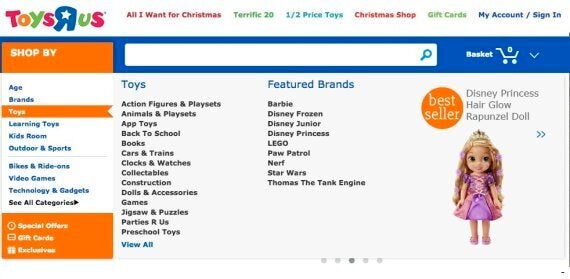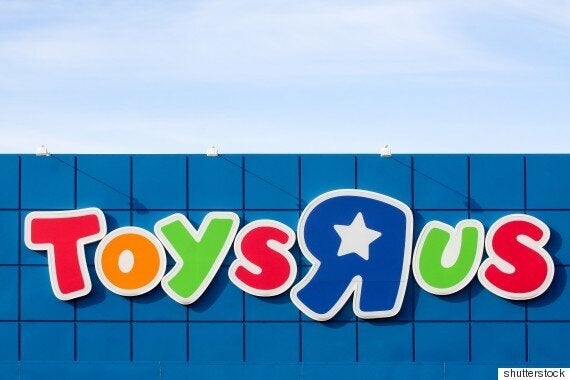Toys R Us has dropped the 'boys' and 'girls' categories from its online store in a drive towards being more inclusive.
The retailer's site still gives customers plenty of ways to sort toys, including age range, brand and genre, but there is no longer a gender filter.
The move from Toys R Us comes after Let Toys Be Toys, a campaign group striving for more inclusivity in toys for kids, met with the retailer in 2013 to discuss the limitations of gendered marketing for toys.

Categories under "toys" no longer include gender
Jess Day from Let Toys Be Toys, told HuffPost UK Parents: "We're really delighted with this change from Toys R Us.
"This is one of a range of changes they've made over the last couple of years to market toys more inclusively, such as more informative in-store signage (dolls instead of 'girls' for example) and organising toys more logically (Lego Friends with other Lego under 'construction', instead of under 'girls')."
Many have praised the move by Toys R Us on Twitter.
Simon Ragoonanan, blogger at Man Vs. Pink was also happy with the news.
He told HuffPost UK Parents: "I think this is a great move. It's a recognition that instead of buying toys for either boys or girls, we are buying toys for our children as individuals.
"Shopping for toys via gendered categories - as well as being needlessly sexist - is increasingly frustrating.
"The divide between what is perceived as a toy for either girls or boys is changing all the time. There are boys who love Frozen, girls who love Star Wars.
"For anyone worried that the lack of gendered categories will be confusing, then get to know the child you are buying for better, and choose something for them that they like, instead of an assumption based on their gender."

Changing the online categories was the third and final issue that the campaign group Let Toys Be Toys urged tToys R Us to change.
During the initial meetings between Toys R Us comes and Let Toys Be Toys in 2013, the retailer's representatives were keen to hear Day's concerns about their gendered toy categories.
Day said: "We discussed three main issues: in-store signage, images in their catalogue, and online categories.
"They agreed to change the first two (although they warned it might take time), but were less convinced about changing web categories as they felt they were genuinely useful to customers.
"We have never felt that categories such as 'cars' or 'dolls' make shopping harder, than 'boys' or 'girls' so this was disappointing.
"Over time we have seen them make the changes they promised.
"Their catalogues are more inclusive (although there is still some work to do) and the signs in-store are starting to come down.
"I wouldn't hesitate to take my children to our local store now, there's nothing to make them think they've made a mistake if they choose a toy from the 'wrong' aisle."
Day said since her campaign launched in 2012, fourteen retailers have agreed to drop 'girls' and 'boys' signs from toy shops.
She said: "This is certainly part of a broader retail trend recognising that dividing by gender may be a simple way to divide up the children's market, but it fails to recognise children's real diversity.
"Unfortunately, many toy manufacturers have yet to move on, and are still developing and marketing toys to target boys or girls specifically. We'd like to see more toys that take a child's interests as a start point, instead of their gender."
The campaigner is currently working on her 'Let Books Be Books' campaign, which has seen nine publishers agree to remove 'boys' and 'girls' labels from story and activity books.
Ragoonanan says he feels the next big area to tackle is children's clothing, which shares many of the same preconceptions as toys in terms of what styles, colours, and characters children like based on their gender.
He added: "As a parent, it's frustrating to have to search in both the boy and girl sections for clothing for my daughter."